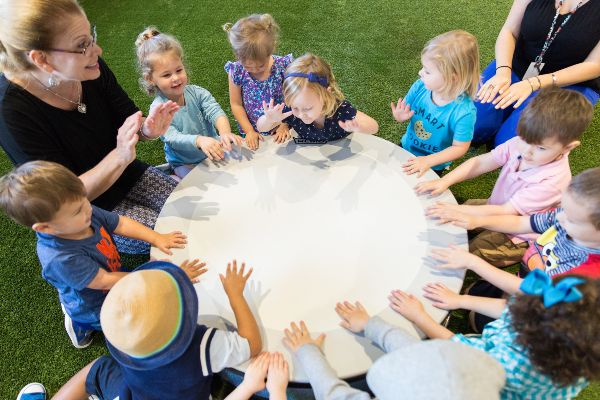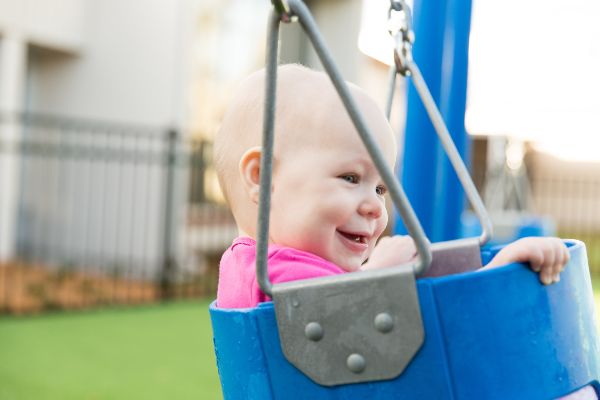All photos courtesy of Saint Paul's School.
Article by Samantha Campbell and Katie Sibsom, Saint Paul's School
As a proud model of K-8 education, Saint Paul’s School has been educating leaders in the community of Clearwater, Florida, for the last 50 years. Three years ago, we were searching for ways to ensure that legacy continued well into the future. During a board of trustees meeting, a simple question changed the trajectory of the strategic vision and financial outlook for Saint Paul’s — “Clearwater’s Independent School,” as we call it.
That question: “Are we using all of our academic spaces to their full capacity?” The answer was no. Approximately 3,000 square feet of the Early Learning Center, which at the time served ages three to kindergarten, were unused during school hours. From there, a lively and at times humorous debate erupted about what we could do with that space to develop auxiliary revenue, increase enrollment, build community or elevate the school’s relevance in the greater community. We quickly generated lofty designs to transform the square footage into something fresh. We were willing to rent, renovate or repurpose this underutilized space.
The discussion engulfed that board meeting and the next, stretching into an optional evening focus group that 100 percent of the trustees attended. We took “field trips” through our buildings and a neighboring school. Ideas crept into our dreams and our daily dialogue via texts, emails and carpool conversations. We conducted informal surveys of friends and family, evaluated our latest demographic studies, investigated possible franchises, and balanced heartfelt responses from long-tenured trustees who were concerned that we would veer too far from the founders’ ideals.
All that analysis and discourse ended with a six-letter solution: BABIES. Many parents had lamented the difficulty of getting their infants and toddlers into overfull day-care facilities in the greater Tampa area. Could we help bridge the gap?
Wrestling with Tradition
The founders of Saint Paul’s set out to combine superior academics with the Episcopal values of respect, honesty and integrity. Our graduates go on to attend the high schools and colleges of their choice, and our alumni lead major corporations, are high-ranking government officials, tour with country music stars, produce network TV series, and practice medicine and law. At face value, this legacy might seem to be in stark contrast to the world of diapers and tummy time.

Our trustees, however, jumped at the opportunity to boldly reimagine our purpose and stabilize our finances without regard to past reference points. We voted to begin three new programs: Infants (2-12 months), “Waddlers” (12-24 months) and Toddlers (24-36 months), and to renovate the 13,000 square foot building that housed our Early Learning Center. The whole process, from initial provocation to deciding vote, took less than six months, and each trustee voted with full knowledge of the financial and cultural ramifications we would have to face together. To raise the more than $1.1 million necessary, we ran a quiet fundraising campaign from October 2015 through February 2016, with Samantha (head of school) making individual asks of current and former parents.
As expected, the announcement of our plans elicited varying degrees of optimism and skepticism by our three main constituencies: faculty and staff, current families and alumni.
As expected, the announcement of our plans elicited varying degrees of optimism and skepticism by our three main constituencies: faculty and staff, current families and alumni. The natural progression of questions paralleled the board’s questions months earlier. They began at the micro-level: Where will we put the diapers? Will the infants go to art and music? Will there be enough parking? How many infants can you have in one room? Will the older students be receptive to having infants on campus? Will the infants move to the next room on their birthdays or at the end of the year? Will the new programs need room parents? Will these new students be in the yearbook? Will they wear uniforms?
These concerns eventually blossomed into more strategic questions: Will the three new programs run on a calendar year or a school year? Will they operate over the traditional holiday breaks? How will their tuition schedule work with rolling admissions? How do you screen babies? Is there a curriculum for babies and toddlers? Will the new programs need to be licensed through the state? How do you evacuate children for a fire drill? Will their presence water down the academic rigor and reputation of the school?
As with any major change, communication in all forms proved crucial in holding the community’s hands through the process. We used the concerns brought forth as a springboard to outline our monthly messages from the head of school, our weekly newsletters, and our talking points for faculty and staff.
Building and Selling the Dream
As with any major change, communication in all forms proved crucial in holding the community’s hands through the process.
The renovation took 12 weeks. Licensing was the most difficult obstacle, given the additional precautions involving children at these tender ages. We had to meet more than 500 Florida state standards, one of which changed in the middle of both our construction and hiring process. It increased the demands of teacher background checks, requiring level-two screenings from every state that a hire had resided in over the past five years. Some states were very slow to respond to our requests, delaying the start dates of some new teachers.

In the meantime, prospective families interested in the new programs scheduled meetings with Katie, our director of enrollment management. They anticipated a comprehensive tour of the new facility, wanted to meet the teachers and to ask detailed questions regarding contracts, admission, protocol, safety procedures and communication. Armed with only an artist’s renderings of the facility, sample tuition schedules based on our budget model and the stringent state requirements, we quickly had more interest than we could accommodate. We were fortunate that Saint Paul’s is well known in the area, and that we could lean on the school’s strong value proposition. We also leveraged our existing resources, including a secure 12-acre campus, a full-time registered nurse and a strong sense of community.
A Flood of Interest
When our redesigned and renovated Early Learning Center opened in the fall of 2016, all three of the new programs were fully subscribed. The interest generated by the building project and publicity for the three new programs breathed new life into our older early childhood program. We opened an additional class in both preschool (three-year-olds) and junior kindergarten (four-year-olds). Overall, our enrollment has increased 32 percent, from 260 students in 2015 to 344 in 2018, and the waiting lists for our Infants, Waddlers and Toddlers programs are robust. Families often wait 16-24 months before being accepted. Our net tuition revenue and annual fund donations also swelled as a result.
We would hesitate to build a new facility on an existing campus or rent additional space, as the cost of increased utilities, rent, taxes, groundskeepers, maintenance and additional staff could diminish any return on investment.
We would encourage any school looking for creative ways to increase enrollment to examine their latest demographic studies and investigate the waiting lists and weekly rates at local day-care facilities. Very early childhood programs require low student-teacher ratios, so a steep weekly rate/tuition schedule is necessary to be profitable.
Also closely examine state licensing requirements, especially student/caregiver ratios and physical facility and outdoor play space requirements. Costly renovations may be necessary to meet code. We would hesitate to build a new facility on an existing campus or rent additional space, as the cost of increased utilities, rent, taxes, groundskeepers, maintenance and additional staff could diminish any return on investment.
Finally, when creating a pro forma budget or forecast for these programs, look at their long-term effect on your total school enrollment as well as how they will perform financially independently from the rest of the school.
Transforming 3,000 square feet of underutilized academic space has given our flywheel a big push. It has resulted in a new legacy of innovation and courage that will define this board of trustees’ body of work and has given Saint Paul’s the bright future we always expected.



